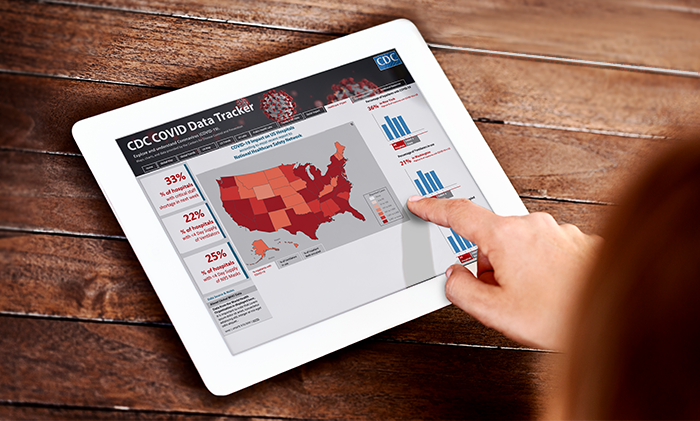Recommendations for Fully Vaccinated People
COVID-19 Homepage
Surveillance and Data Analytics
The Latest in COVID-19 Data and Surveillance
This page provides information and resources to help public health departments and laboratories investigate and report COVID-19 cases.
Key concepts
- Report COVID-19 cases. CDC has developed a form that provides a standardized approach to reporting COVID-19 cases (individuals with at least one respiratory specimen that tested positive for the virus that causes COVID-19). These data are needed to track the impact of the outbreak and inform public health response.
- Monitor COVID-19 cases. COVID-19 surveillance draws from a combination of data sources from existing influenza and viral respiratory disease surveillance, syndromic surveillance, case reporting, commercial lab reporting, ongoing research platforms, and other new systems designed to answer specific questions. These systems combined create an updated, accurate picture of SARS-COV-2 spread and its effects in the United States and provide data used to inform the U.S. national public health response to COVID-19.
Resources from CDC
For surveillance of COVID-19 and its cause, SARS-CoV-2, in the United States, CDC is using multiple surveillance systems run in collaboration with state, local and territorial health departments, public health, commercial and clinical laboratories, vital statistics offices, health care providers, emergency departments and academic partners to monitor COVID-19 disease in the United States.
- COVID Data Tracker Weekly Review
This CDC report provides a weekly summary and interpretation of key indicators that have been adapted to track the COVID-19 pandemic in the United States. - Cases in U.S.
This page is updated daily. Numbers close out at 4 p.m. the day before reporting. - Hospitalization Rates
CDC monitors lab-confirmed COVID-19 hospitalizations, risk factors, and outcomes of those hospitalized each week. - Mortality Reporting
CDC provides provisional death counts for COVID-19 and pneumonia based on death certificates with updates Monday-Friday. - Information for Reporting Cases
To prevent further spread of SARS-CoV-2 and to collect information to better understand the virus and its impact on health outcomes, CDC has developed a form that provides a standardized approach to reporting COVID-19 cases (individuals with at least one respiratory specimen that tested positive for the virus that causes COVID-19). - Information for Reporting Cases in Fully Vaccinated People (Vaccine Breakthrough Cases)
CDC would like to characterize the SARS-CoV-2 lineages responsible for COVID-19 cases in fully vaccinated people, including variants. CDC encourages local health departments, healthcare providers, and clinical laboratories that identify a COVID-19 such cases to request a respiratory specimen and report the case to the state health department. - COVID-NET Interactive
Interactive and downloadable data used to estimate age-specific hospitalization rates on a weekly basis and describe characteristics of persons hospitalized with COVID-19. - CDC COVID-19 Information Management Resources (VADS)
CDC develops and maintains the COVID-19 data interoperability standards and regulations repository that is based on communication and collaboration with standard development and standard implementation organizations. - eCR Now: COVID-19 Electronic Case Reporting
Electronic Case Reporting (eCR) is the automated generation and transmission of case reports from the electronic health record (EHR) to public health agencies for review and action. - Calculating Percent PositivityExternal
For the federal COVID-19 response reporting purposes, laboratory test percent positivity represents the percentage of all RT-PCR tests conducted that are positive.
National COVID-19 reporting: CDC works with state and territorial public health partners to coordinate COVID-19 case reporting nationally.
- Standardized Surveillance Case Definition Pdf[PDF – 19 pages]External
The COVID-19 case definition is standardized with the Council of State and Territorial Epidemiologists (CSTE), which approved an interim COVID-19 position statement on August 5, 2020. This position statement, Interim 20-ID-02, Pdf[309 KB, 19 Pages]External supersedes the first CSTE COVID-19 interim position statement, Interim 20-ID-01, which was approved on April 5, 2020. The August position statement updated the standardized case definition for COVID-19, including asymptomatic infections caused by SARS-CoV-2, and retained COVID-19 as a nationally notifiable condition. The updates clarified clinical, laboratory, epidemiologic linkage, and vital records criteria for case ascertainment and case classification based on the continued evolution of the COVID-19 pandemic. In addition, the probable case classification was updated, and a suspected case classification was added. - Information for Reporting Cases
To better understand the virus and its impact on health outcomes, CDC has developed a form that provides a standardized approach to reporting COVID-19 cases (individuals with at least one respiratory specimen that tested positive for the virus that causes COVID-19). - National Notifiable Diseases Surveillance System (NNDSS)
Case-based surveillance (which includes mechanisms to securely receive case data and share with CDC partners and technical assistance with onboarding new HL7 message mapping guides). - National Syndromic Surveillance Program (NSSP)
Includes Emergency Department visits for onboarded facilities and COVID-19 test orders and results for 6 major commercial laboratories.
*Requires an account with NSSP to access* - NSSP for syndromic surveillanceExternal
Includes access to the RShiny app - Electronic Surveillance System for the Early Notification of Community-based Epidemics (ESSENCE)
For quality-controlled line-level data for ED visits and 6 major commercial labs testing for COVID-19—including PCR and as of now IgA, IgG, and IgM as well; ESSENCE also provides advanced tools to rapidly query, visualize and analyze these data).
Resources from other organizations
Content describing non-CDC tools on this site is provided for informational purposes only and is not intended to indicate endorsement, actual or implied, of the tools. Additionally, information on this site is provided “as is,” for users to evaluate and make their own determination as to their effectiveness.
Private sector, non-governmental organizations and academia
Various other organizations are also supporting this critical effort by providing:
- Google Community Mobility ReportsExternal
Aim to provide insights into what has changed in response to policies aimed at combating COVID-19.
